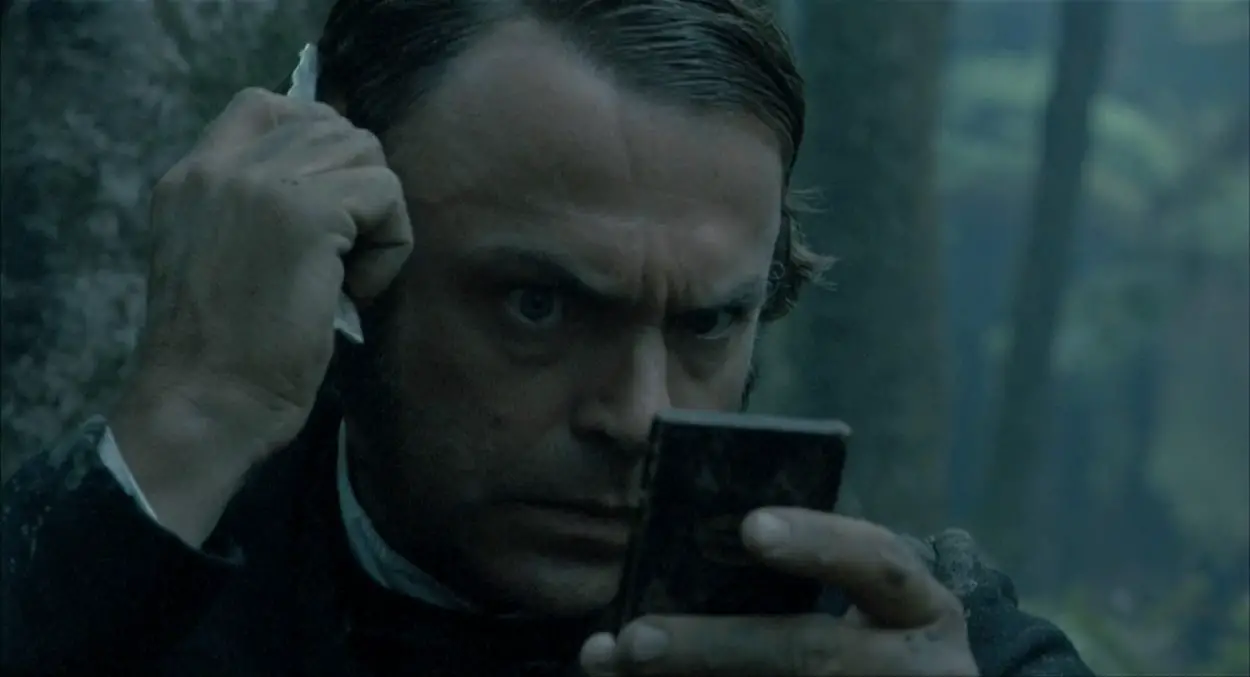Thematically, Jane Campion’s 1993 The Piano primarily explores a Victorian woman’s need for autonomy and control in a society that dominates, controls, and suppresses her, surrounded by men who seemingly live to quash her willful, artistic spirit. Much has been written about that struggle for control, and of the amazing music that weaves throughout the wilds of the characters’ lives. The question that interests me currently is: what of those men? Especially, what of Alisdair Stewart? How did he seemingly descend from the classic, top-hatted gentleman into a raging, finger-chopping dirtbag?
Campion’s exquisite writing and directing, Michael Nyman’s unbelievably beautiful score, and the actors’ masterly performances blend seamlessly to complete a journey of immense beauty, rising from the muddy depths. Through Ada’s story, this filmmaker exquisitely shows the weakness and frailty of spirit required for any person to show themselves as such a failure.
Sam Neill‘s Alisdair Stewart begins the film as a man awkwardly trying to maintain superior social status through any means necessary, fighting against understanding and adapting to his jungle environment, Maori neighbors, and the other white people in his settlement.
His counterpart and white neighbor, Harvey Keitel’s character George Baines, immerses himself into the landscape, native culture, and societal freedom of a New Zealand settlement at the time. Eventually, Stewart mutilates his wife, and Baines takes her away to lead a new life unencumbered by Stewart’s control.
By the end of the film, Stewart has nothing more in the way of personal growth than when he married Ada, while Baines abandons his self-described wretchedness and shares a happy life and love with Ada. What motivates Stewart to stagnate in his fight against growth, and Baines to flourish while acquiescing to his environment? I maintain the motivation for the former is fear, and for the latter is love.
Ada delivers our first glimpse of Stewart’s personality, from a letter stating, “God loves dumb creatures, so why not he?” She narrates the letter with her “mind’s voice.”
A simple statement like this reveals his aspiration to Godlike status, as well as his desire to wed a woman who will not speak, the ultimate attribute of a wife for a man who fears the loss of control. Of course he fails to account for the fact that she has other ways of communicating and defying his wishes, even in her silence, but this marriage must have sounded like an ideal situation to him.
The first visual of Stewart, he’s dressed in fine clothes, complete with top hat, trudging through deep jungle mud to reach his new bride. Accompanied by Baines and a group of Maoris, Stewart appears ridiculously out of place, and completely lacking in self-awareness. While Baines and the Maoris all wear a mixture of clothing, they’ve dressed for work and for the harsh terrain. Stewart stops the group in order to remove his top hat, straighten his hair, and keep up appearances.

When a man is concerned with such things, he appears narcissistic. What interests me is the question of what’s underneath that. What drives a man to need to appear so “together,” to be so thoroughly consumed with surface appearances? What would happen if he arrived on the beach disheveled and dressed for what was really happening instead of whatever delusions he harbors about class and society’s expectations?
To investigate those questions, let’s contrast Stewart to Baines. Starting with the actors, Sam Neill is traditionally handsome, with a face that could easily double for those on ancient Grecian statues. Stewart’s comportment and dress suggest upper middle class, with high social aspirations. Harvey Keitel’s wild, curly hair and weathered skin are also handsome, and in a way that requires a closer look. He’s traditionally cast as a bruiser/enforcer type, whereas Neill usually plays romantic leads, handsome father figures, or suave bad guys. Keitel’s character Baines has a mostly-finished Maori tattoo obscuring some of his features. Baines speaks the Maori language, serving as translator for Stewart. He’s melded with the jungle, in dress, comportment, face, and body. Everything about Baines suggests he’s integrated, both externally and internally.
In short, Baines is everything Stewart fears, and Stewart has no idea why, or why fearing integration of self could possibly be a bad thing for him and the people around him.

Upon meeting Ada, Stewart’s preoccupation with the superficial and Baines’ focus on what lies beneath becomes even clearer. Stewart asks Baines what he thinks of Ada. Baines replies, “She looks tired.”
Stewart remarks on her appearance, stating, “She’s stunted.”
His new wife just spent the night on a beach after traveling thousands of miles, and he can only comment that she’s short. Baines, having no personal stake, still looks to understand this woman and what she’s doing through.
I recently asked a wonderful acting and creativity teacher what drives people to narcissism and controlling personalities. She replied, “I would ask, what do they fear losing?” With Stewart, on the surface, it’s social status. Peeling back all of the layers, one by one, she said, it usually comes down to fear of being unlovable. That extreme fear can drive one to very unlovable behavior, as exemplified by Stewart.
Stewart frequently expresses his desire for Ada’s affections, at the same time denying her the only thing she desires from him: her piano. Her piano would be the one thing she could use to communicate and express her spirit and intentions in her home, but he will not allow it. He still clings to the image of a silent and obedient wife who will not challenge him in any way.
He makes no gestures toward understanding her. His consistent inability and unwillingness to see things from a perspective other than his own carries over to his dealings with the Maori. They refuse to sell him their sacred land, where their ancestors are buried and reject his offers of blankets as a trade for it.
Stewart asks, “What do they want it for? They don’t cultivate it, burn it back, anything. How do they even know it’s theirs?” He sees land as he sees people: something to own, groom, and tame.
As Ada’s affair with Baines progresses, Stewart’s violent and controlling nature take over. After spying on them have sex in Baines’ hut, Stewart attempts to imprison Ada. He attempts to rape her. She pretends to want physical intimacy with him, and he loosens his restrictions on her. Of course, as soon as those restrictions are lifted, Ada tries to send word of her love to Baines, which backfires miserably. Ada’s daughter Flora takes the inscribed piano key professing her love for Baines straight to Stewart, who returns to Ada in a rage. He swings his ax at her piano, demanding rhetorically, “Why do you do this? Why do you make me hurt you?…You have made me angry. SPEAK!”
In maybe the most famous scene in the film, he then proceeds to drag her out to the chopping block in the yard and chop off her index finger. Through his anger, he shirks all responsibility for his actions that render him unlovable by Ada. As she crumples into the mud, clutching her injured hand, he doubles down with a quick gaslight. “I clipped your wing. That’s all.” The sad part is, I really think he believes this. In his muddled view, he has offered her all he has, and that should be enough.
He still does not understand that all of his possessions, all of his land, all of his body, mind, spirit, and heart; everything he has to offer, is not nearly enough.

Ada sees through him, to his empty, fearful, fragile core, and that is the one thing he cannot bear. His protestation that they could be happy and that he could love her imply the words, “If only.” He could love her and they could be happy if only she would set her will and her desires aside and be content with the hollow, shell of a companion he offers her. They could be happy if only she would be as silent in spirit as she is with her muteness. They could be happy if she played a jig on the piano instead of songs described by a servant as “a mood that passes into you.” He screams at her to speak, as if willing her to say she will abandon her wishes and be the ornamental human accessory he wishes.
Even as Ada lies unconscious from pain, Stewart can’t stop himself from trying to force his weak intimacy on her. Aroused, he tries to rape her, stopped only when she wakes and looks him in the eyes. Shamed, and shocked, he stops.
Something transpires between them, which we only find out about when Stewart discusses it with Baines. He explains that he heard her voice asking him to let her go away with Baines in his mind, and finally understood. He explains to Baines that he only wants them both gone, and to pretend the whole experience was a dream. He says, “I want to believe I am not this man. I want my self back; the one I know.”
Baines and Ada, who have been the mirrors reflecting Stewart back to himself, are anathema to him. He hates himself, and since their mirror natures bring out the violent, angry, lonely, empty parts of himself, he hates them too. By merely existing in his space, they managed to peel back the layers of Alisdair Stewart, and have discovered and revealed that he is, in fact, unlovable. His worst fears confirmed, he wants to re-wrap himself in the cocoon of pretense and superficiality to which he’s become accustomed.
Upon Ada, Baines, and Flora’s departure, we’re left wondering what became of Alisdair Stewart and his top hat. My inclination is to believe he carried on as he had been, neither understanding nor caring about integrating himself into the world around him or learning to respect and integrate the superficial and painfully fragile inner parts of himself in order to become whole.
Jane Campion is a master storyteller. Every character is as distinct and fully-formed as real-life humans. The cinematography itself tells a tale: muted, cool filters when Ada’s life is out of her control. Warm, saturated tones when her will shines through. Through the telling of Ada’s story, Campion doesn’t just lay out a series of actions and manipulations used by one woman to survive, she shows the incredible danger and damage done by the patriarchy, personified in Alisdair Stewart. Via George Baines, she shows a gentler alternative, a choice to love and nurture, casting aside the desire to own and control.
In the end, Ada, settles in a westernized town with Baines and Flora, lulling herself to sleep at night with the “weird lullaby” image of herself at the bottom of the ocean, tethered to her sunken piano.
I suspect at the same time, that Stewart’s top hat still adorns the top of his lonely, perplexed, unloved, unloving, and angry head, in that wild jungle, as far away from the mud as he can carry it.




